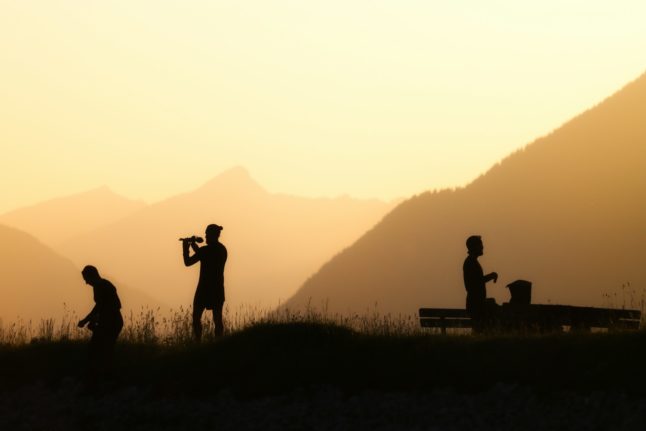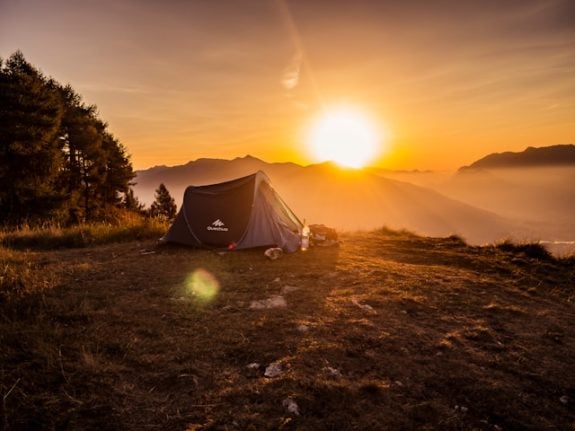Austria offers endless possibilities for hiking and trekking in its beautiful mountains, forests and trails. The Alpine country is a worldwide destination for wanderers, but trekking in its mountains is very demanding, and people should be prepared.
Even born-and-raised Austrians are not immune to the dangers of the mountains, as one incident with President Alexander Van der Bellen shows.
READ ALSO: The six most spectacular train trips in Austria
The president, in the middle of running a reelection campaign in 2022, suffered a mountaineering accident while trekking in Kaunergrat park, west of Austria.
“Federal President Van der Bellen suffered minor injuries in a mountain accident on Sunday afternoon. He slipped on a mountain hike on the Kaunergrat and was taken to the nearest hospital by Cobra attendants.”, his team posted on social media.
ℹ️ Bundespräsident Van der Bellen hat sich am Sonntagnachmittag bei einem Bergunfall leichte Verletzungen zugezogen. Er ist bei einer Bergwanderung am Kaunergrat abgerutscht und wurde von Begleitern der Cobra in das nächstgelegene Krankenhaus gebracht. (1/2)
— A. Van der Bellen (@vanderbellen) August 21, 2022
The tweeted message reads: “The Federal President suffered abrasions and a slight concussion and will spend the night in hospital on the advice of the doctors treating him. He will cancel his appointments at the Forum Alpbach on Monday and Tuesday.”
While 78-year-old politician (fortunately) recovered from the accident, many are not that lucky. Unfortunately, accidents in the Austrian alps are not a rare occasion, with more than 2,500 happening to trekkers and hikers in 2021.
READ ALSO: Five of the best weekend getaways from Vienna
Last year, 272 people died in the Austrian alps, a number slightly below the long-term average of 286 deaths yearly. However, many believe the decrease is due to bad weather (as most accidents happen in summer) and coronavirus restrictions keeping people at home, according to the Alpenverein.
What are the main recommendations when hiking?
Austria’s Alpine Association has a series of entertaining videos with dozens of tips for those looking to adventure in the Austrian mountains during the summer.
READ ALSO: 15 things to do in Austria in summer 2022
The videos feature a couple, Berti and Gerti, who want to enjoy the spectacular landscapes of the Alps but are followed by the “clumsy grim reaper” (no joke) every step of the way.
The videos are subtitled in English and worth the watch – if only for the sheer Austrianess of watching Death wearing Lederhosen.

You can watch all the videos here.
The ten tips to hiking in the Austrian Alps
According to Alpenverein, there are seven points that every hiker needs to be aware of.
Be in good health
“Mountain walking is an endurance sport. It makes your heart and circulation work, so good health and an honest assessment of your capabilities are required. Avoid having to rush and adopt a pace that keeps all members of your group from getting out of breath.”, it says.
According to the association, heart attacks are the second most frequent main of death (accounting for 40 percent) in mountain hiking. Men older than 40 are the leading risk group, and several factors contribute to this risk growing.
Plan and prepare carefully
“Mountain hiking is not a walk in the park”, the Alpenverein alerts. Careful preparation is essential; hikers need to know the trail and surroundings well, check and prepare for the weather, account for each group member and their particular fitness level (especially if there are elderly or children), and check the current trail conditions beforehand and gather the proper equipment.
READ MORE: How to explore the Austrian mountains in the summer like a local
The Verein has a handy tip to calculate walking time for a medium-sized group of four to six people: allow one hour for every 300m climbed, one hour for every 500m descendant and one hour for every four kilometres walked.
Walking times for the altitude and horizontal distance are calculated separately. Their smaller value is divided by two and then added to the larger one.
So, for example, if an alpine trail climbs 1,200 metres of altitude (which equals four hours of walking time) and covers a horizontal distance of eight kilometres (two hours). The total uphill walking time would be four hours plus one (the two hours divided by two), or five hours.
Come fully equipped
Ensure you have the right equipment for your undertaking and keep your rucksack light. Rain gear and cold and sun protection should always be in your backpack, as should a first aid kit and mobile phone (European emergency number 112).
You should also bring some food and drink and light. A hiking map, app or GPS will help you find your way.
Hike in appropriate footwear
This item is so essential that the Alpenverein has it listed separately. This is because stable hiking boots protect and take a load off your feet. They are also vital to improve your sure-footednese and avoid falls.
Choose waterproof, lightweight boots with a perfect fit and good grip. If possible, shop where there are experts offering advice and take your time finding the ideal hiking boot for you.
Surefootedness is key
The leading cause of accidents in hiking the alps is falling from slipping or tripping. Be aware of keeping a comfortable pace and mind that fatigue can seriously affect your surefootedness and concentration, especially when descending.
“Steep descents require your body’s centre of gravity over your feet: bend your knees slightly, bring your upper body a little forward and round your upper back a bit. If the descents are long and challenging, take breaks”.
READ ALSO: Why getting rescued in the Austrian Alps could cost you thousands

Stay on marked trails
In pathless terrain, the risk of losing your orientation and falling from heights and rockfalls increases.
Avoid shortcuts and return to where you last knew your position if you lost your way. It is not uncommon for shortcuts or alternative routes to end in rough and challenging terrain.
Make regular breaks
Regular breaks give the body time to relax and allow you to enjoy the landscape, and keep your concentration levels high. Additionally, you should eat and drink to maintain your performance and attention focus.
Hike responsibly with children
Hiking with children adds a massive responsibility to adults, and only one adult can look after one child during a hike. Therefore, prepare beforehand and check if the walk is suitable for children before embarking on it.
READ ALSO: Austrian rescuers save 100 German school children stuck while hiking in Alps
Hike in small groups
Small groups are more flexible and make it possible for the members to help each other out easily. Always stay with your group. The ideal group size for mountain hiking is four to six people, and any hikes with groups of far more than eight people “quickly become chaotic outings”, the association says.
Respect nature and the environment
This should go without saying, but: do not leave any waste behind, refrain from making too much noise, stay on the trails and don’t disturb wild animals or plants.
READ ALSO: ‘Waldeinsamkeit’ in Austria: Five peaceful forest walks near Vienna





 Please whitelist us to continue reading.
Please whitelist us to continue reading.
Member comments